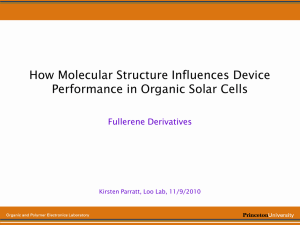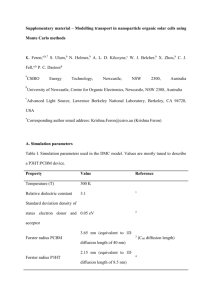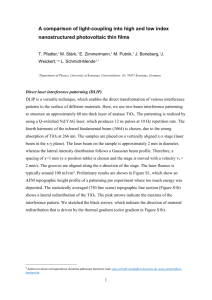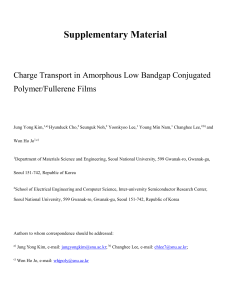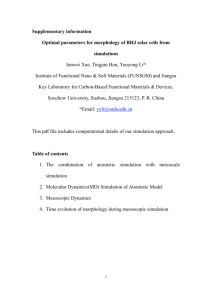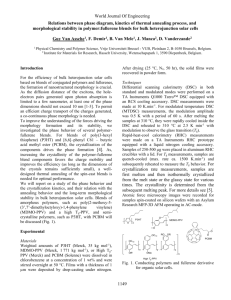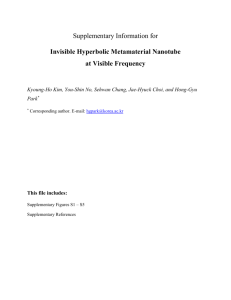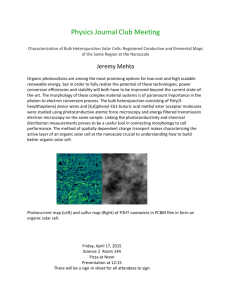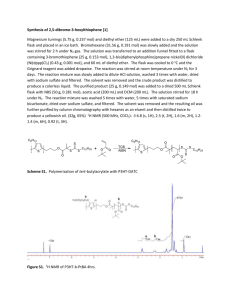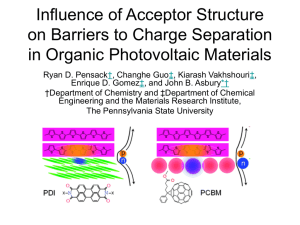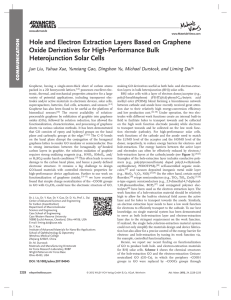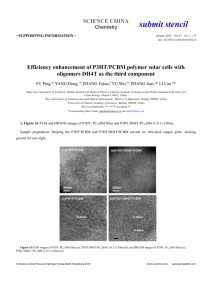Supporting information
advertisement
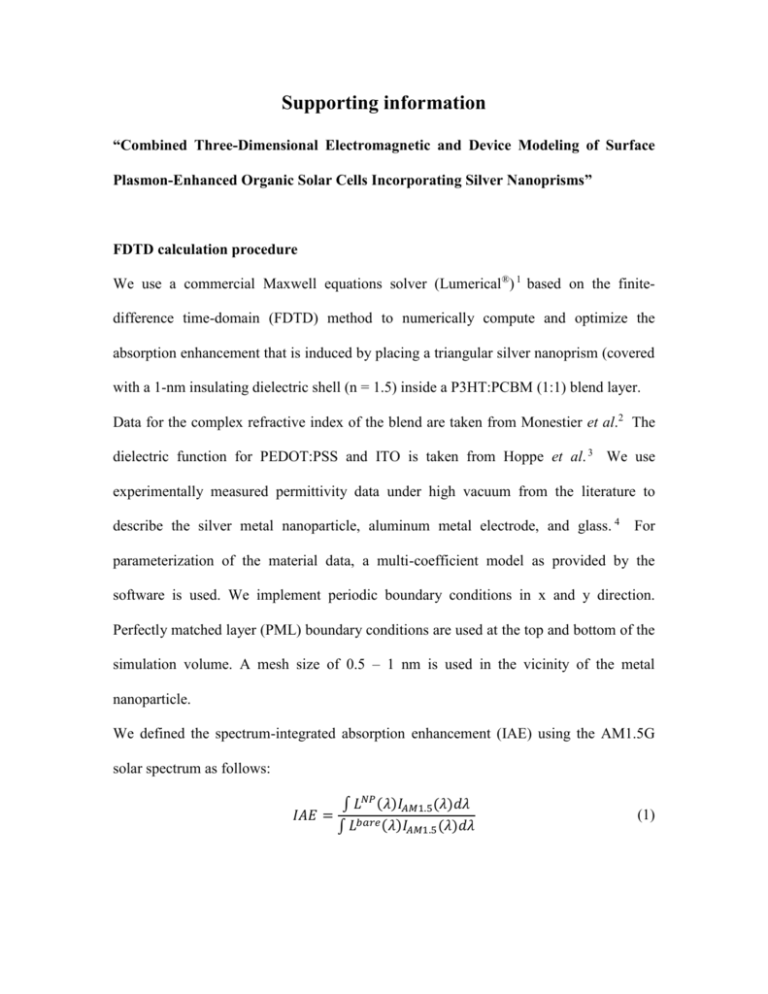
Supporting information
“Combined Three-Dimensional Electromagnetic and Device Modeling of Surface
Plasmon-Enhanced Organic Solar Cells Incorporating Silver Nanoprisms”
FDTD calculation procedure
We use a commercial Maxwell equations solver (Lumerical ®) 1 based on the finitedifference time-domain (FDTD) method to numerically compute and optimize the
absorption enhancement that is induced by placing a triangular silver nanoprism (covered
with a 1-nm insulating dielectric shell (n = 1.5) inside a P3HT:PCBM (1:1) blend layer.
Data for the complex refractive index of the blend are taken from Monestier et al.2 The
dielectric function for PEDOT:PSS and ITO is taken from Hoppe et al. 3 We use
experimentally measured permittivity data under high vacuum from the literature to
describe the silver metal nanoparticle, aluminum metal electrode, and glass. 4 For
parameterization of the material data, a multi-coefficient model as provided by the
software is used. We implement periodic boundary conditions in x and y direction.
Perfectly matched layer (PML) boundary conditions are used at the top and bottom of the
simulation volume. A mesh size of 0.5 – 1 nm is used in the vicinity of the metal
nanoparticle.
We defined the spectrum-integrated absorption enhancement (IAE) using the AM1.5G
solar spectrum as follows:
𝐼𝐴𝐸 =
∫ 𝐿𝑁𝑃 (𝜆)𝐼𝐴𝑀1.5 (𝜆)𝑑𝜆
∫ 𝐿𝑏𝑎𝑟𝑒 (𝜆)𝐼𝐴𝑀1.5 (𝜆)𝑑𝜆
(1)
where LNP and Lbare are the optical absorption in the blend with and without nanoparticles,
respectively.
For optimizing the particle dimensions and density of the nanoparticle array we used the
particle swarm algorithm5 from the Lumerical software to aim for maximum IAE inside
the blend layer. The particle swarm algorithm consisted of 40 generations, each featuring
20 simulations (800 simulations overall). Based on previous experimental work and
experience, 6 the range of possible particle dimensions and periods was limited to:
thickness: 5 – 15 nm, edge length: 5 – 50 nm, period: 150 – particle edge length. Figure
S1 shows the result of one optimization process, in which the smallest possible period
was set to be 62 nm.
Figure S1. Result of one particle swarm optimization. The smallest possible period was
set to be 62 nm. The graphs show (left to right) the optimization of the nanoparticle side
length, period, thickness (includes a 1 nm thick dielectric shell) and the resulting
absorption enhancement as a function of the number of generations.
Calculation of current-voltage (I-V) and quantum efficiency (EQE, IQE) curves
The short-circuit current density JSC can be calculated as the average photocurrent at the
surface of the solar cell:7
⃑jSC (λ) =
1
∭|j⃑n (x⃑⃑, λ) + ⃑jp (x⃑⃑, λ)|dV
V
V
where V is the volume of the solar cell and Jn and Jp are the electron and hole driftdiffusion currents, respectively, as explained in the main text. The wavelength integrated
short-circuit current can be calculated as 𝐽⃑𝑆𝐶 = ∫ ⃑jSC (λ)dλ.
The current-voltage (I-V) response of the solar cells can be written as:
𝑞𝑉
𝐽⃑(𝑉) = 𝐽⃑0 [𝑒𝑥𝑝 (𝑘 𝑇) − 1] − 𝐽⃑𝑆𝐶
𝐵
where ⃑J0 is the reverse saturation current.
The open-circuit voltage (VOC) is the voltage at which 𝐽⃑(𝑉) = 0:
𝑉𝑂𝐶 =
⃑JSC
kBT
𝑙𝑛 ( + 1)
𝑞
⃑J0
The maximum power density (Pmax) is:
𝑃𝑚𝑎𝑥 = 𝑚𝑎𝑥{𝐽⃑(𝑉) ∙ 𝑉} = 𝑚𝑎𝑥 {𝐽⃑0 ∙ 𝑉 [𝑒𝑥𝑝 (𝑘𝑞𝑉𝑇) − 1] − 𝐽⃑𝑆𝐶 ∙ 𝑉}.
𝐵
The fill factor is:
𝑃𝑚𝑎𝑥
𝐹𝐹 = 𝐽
𝑠𝑐 ∙𝑉𝑂𝐶
.
The frequency-dependent external quantum efficiency (EQE) is defined as:
⃑jSC (λ)⁄
𝜆 ⃑jSC (λ)
𝑞
𝐸𝑄𝐸(𝜆) =
=
𝐽𝐴𝑀1.5 (λ)
𝑞ℎ𝑐 𝐽𝐴𝑀1.5 (λ)
⁄𝐸
𝑝ℎ
where 𝐸𝑝ℎ = ℎ𝑐 ⁄𝜆 is the incident photon energy, and 𝐽𝐴𝑀1.5 (λ) is the incident sunlight
density.
Finally, the internal quantum efficiency (IQE) can be calculated by:
𝐼𝑄𝐸(𝜆) =
𝐸𝑄𝐸(𝜆)
𝐴𝑏𝑠(𝜆)
where Abs(λ) is the absorption in the active layer at wavelength λ.
Parameters used to match current-voltage (I-V) and external quantum efficiency
(EQE) curves
The parameters used to match the experimental I-V and EQE curves of a P3HT:PCBM
(1:1) photodiode (see main text) and used for calculating the behavior of the metal
nanoprism decorated P3HT:PCBM solar cell are listed below.
Parameter
Symbol
Value
Effective trap density
ρtrap
1e16 cm-3
Electron mobility
μe
1e-4 cm2/(Vs)
Hole mobility
μh
1e-4 cm2/(Vs)
LUMO electron affinity for P3HT:PCBM
ELUMO
3.8 eV
HOMO electron affinity for P3HT:PCBM
EHOMO
4.8 eV
Effective DOS in LUMO for P3HT:PCBM
Ne
2.108e18 cm-3
Effective DOS in HOMO for P3HT:PCBM
Nh
1.980e21 cm-3
Width of Gaussian LUMO for P3HT:PCBM
σe
0.032 eV
Width of Gaussian HOMO for P3HT:PCBM
σh
0.027 eV
Relative permittivity P3HT:PCBM
εr
3.8
ITO layer thickness
tITO
100 nm
Work function for ITO
χITO
4.7 eV
PEDOT:PSS layer thickness
tPEDOT
40 nm
Work function for PEDOT:PSS
χPEDOT
5.1 eV
Aluminum layer thickness
tAlu
100 nm
Work function for Aluminum
χAlu
4.475 eV
1
www.lumerical.com
2
F. Monestier, J-J. Simon, P. Torchio, L. Escoubas, F. Flory, S. Bailly, R. de Bettignies,
S. Guillerez, and C. Defranoux, Sol. Energy Mater. Sol. Cells 91, pp. 405 - 410 (2007).
3
H. Hoppe, N. S. Sariciftci, and D. Meissner, Mol. Cryst. Liq. Cryst., 385 (1), pp. 113 –
119 (2010).
4
E. D. Palik, Handbook of Optical Constants of Solids; Academic Press: Orlando, 1985;
Vol. 1.
5
J. Robinson, and Y. Rahmat-Samii, IEEE Trans. Antennas. Propag. 52 (2), pp. 397 - 407
(2004).
6
A. P. Kulkarni, K. M. Noone, K. Munechika, S. R. Guyer, and D. S. Ginger, Nano. Lett.
10 (4), 1501 - 1505 (2010).
7
X. Li, N. P. Hylton, V. Giannini, K. H. Lee, N. J. Ekins-Daukes, and S. A. Maier, Prog.
Photovolt: Res. Appl. 21, 109 - 120 (2013).
